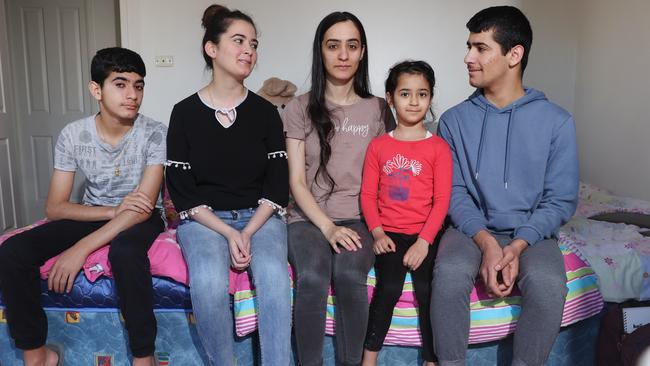James Morrow: Push for Big Australia is back to assist with Covid recovery
The push is on for a big immigration surge post-Covid - but such a move would be economically dangerous and political folly, writes James Morrow.
Opinion
Don't miss out on the headlines from Opinion. Followed categories will be added to My News.
Nature is healing. Beers are being pulled, hairs are being cut, and if any more proof were needed that things were getting back to normal, the Big Australia lobby is back.
Earlier this week it was reported that new NSW Premier Dominic Perrottet was being pushed by bureaucrats on “an aggressive resumption of immigration levels as a key means of economic recovery.”
How aggressive?
Try an additional 400,000 migrants each and every year for the next five years, if the report is to be believed.
He wouldn’t be the only one hearing this message. But he would be smart to resist it.

So too would Scott Morrison, who is only months away from going to the polls with an electorate that has not forgotten the very big conversation on immigration that was just starting up when the pandemic hit.
Because while elite stakeholders – bureaucrats and big business – may be keen to open the floodgates, suburban Australia sees reduced immigration pressures as a souvenir of Covid they would like to hang on to.
Figures released Thursday by the Australian Population Research Institute (TAPRI) tell the story.
Only 19 per cent of voters want to see a return to net overseas migrations similar to what they were before – around 240,000 people a year.
Everyone else wants less than that, including 28 per cent who would be happy with no net migration at all.

A deeper dive into the numbers reveals that most Australians are wise to the fact that while increased migration increases overall GDP, it does little for average people.
They also understand that one of the natural consequences of Australia’s huge reliance on skilled workers means an education system that has been allowed to languish to the point where our maths results dropped below the OECD average in 2019.
Let’s be really blunt here.
Trying to kickstart the economy with another immigration binge when there’s not enough work or places to live is the sort of folly that can only be dreamt up by people who see Australia not as a nation but a hotel.
And heading into an election on a platform of Big Australia will be dangerous business, asking voters to endorse a plan they see as a recipe for extra traffic, larger class sizes, and longstanding suburban communities being steamrolled by flatpack apartment blocks.

Certainly the previous decade of high immigration hasn’t done much to put real wealth in ordinary peoples’ pockets.
And it’s hard to imagine what all these newcomers will do, given there isn’t a huge manufacturing segment to soak them up as during previous migration booms. Is there really a need for 400,000 extra engineers or accountants or what have you per year?
Far more likely is a scenario that would see that many more temporary student visa holders brought in to do low paying, low skilled work that might create economic churn but little in the way of tax receipts or build community.
The numbers tell the tale.
Australia’s per capita GDP in 2010 was around $US52,000, and after a mining boom-related peak in 2013 settled back down to pretty much exactly the same figure ($US51,812) in 2020. Yet over the same decade, our overall GDP grew from $US1.146 trillion to $US1.331.
TAPRI’s head, Bob Birrell, points out that with both sides of politics now as profligate as the other, social issues and not economics will decide the next federal election.
While Labor has not campaigned on immigration as, since the 1990s, both sides of politics have been essentially indistinguishable except on the number of refugees, there are signs that in a close election it might pull this lever.
In March, Labor’s dissenting report for a joint standing committee inquiry into skilled migration was scathing, and laid the groundwork for what could be a profitable line of attack.
“Labor members of the Committee believe the Government must make sure that Australians get a fair go and a first go at skills, training, and secure jobs with fair pay,” the report stated.
“Labour market gaps have emerged while our borders have been shut. Instead of recommending that the Government identify skill shortages and deliver urgent training and re-skilling opportunities to Australian workers so they can fill those jobs, Government members are immediately turning to temporary migration.”
As Birrell says, should Labor go down this road, “the Coalition is vulnerable’’.
“This is because most intending Coalition voters (at the time of the TAPRI survey) are opposed to the Coalition’s Big Australia policy. This opposition is acute among Coalition’s main non-graduate voting constituency.” None of this means that Australia should not be a welcoming nation – this columnist first landed on these shores 20 years ago.
However, being against virtually unrestricted immigration is not tantamount to xenophobia.
But among proponents of high immigration it’s not hard to detect another weird sort of phobia directed at other Australians. The English philosopher called it “oikophobia”, from the Greek for a fear of one’s own home environment.
While he said that it was commonly found on the left, it is also plenty present among those on the libertarian end of the right who think of people only as widgets who can contribute to a balance sheet and not individuals who also share the same culture and place.





